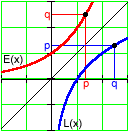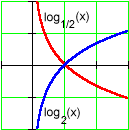Logarithmic Functions
Algebraic Representation![]()
|
f(x) = a log b(x) |
Like an exponential, a logarithm's essential features can be described with just two parameters.
Like an exponential, the parameter b is called the base.
Unlike an exponential, the parameter a is not the y-intercept! Indeed, members of this basic family of logarithms have no y-intercepts. To discover the meaning of a , we must consider more closely the inverse nature of exponentials and logarithms.
Recall that if
|
The equations |
 Exponentials and logarithms are just different ways of expressing this relationship. The function
Exponentials and logarithms are just different ways of expressing this relationship. The function
Consider:
This explains the "mirror image" relationship between exponentials and logarithms with the same base. If (x, y) is an input-output pair for one function, then (y, x) is an input-output pair for the other.
It also helps us to explain the meaning of the parameter a . Since
It is better to think of a as a scaling factor, adjusting the outputs of logb(x) up or down as a increases or decreases, respectively.
Because the base of a logarithm is really the base of an exponential in disguise, we carry over the restriction given for exponentials:
|
The base b in a logarithmic function must be positive. |
For exponentials, this condition assured that outputs from
As with exponential functions, the base is responsible for a logarithmic function's rate of growth or decay.

![]() The key algebraic property of logarithmic functions is the following.
The key algebraic property of logarithmic functions is the following.

That is, multiplying any input x by a constant k results in adding a constant interval
The property of input multiples producing equal output steps is the basis for many logarithmic scales used in applications.
|
|
|
| Back to Contents | |